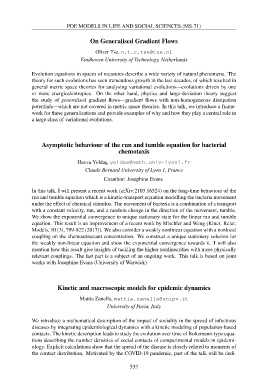Page 535 - 8th European Congress of Mathematics ∙ 20-26 June 2021 ∙ Portorož, Slovenia ∙ Book of Abstracts
P. 535
PDE MODELS IN LIFE AND SOCIAL SCIENCES (MS-71)
On Generalised Gradient Flows
Oliver Tse, o.t.c.tse@tue.nl
Eindhoven University of Technology, Netherlands
Evolution equations in spaces of measures describe a wide variety of natural phenomena. The
theory for such evolutions has seen tremendous growth in the last decades, of which resulted in
general metric space theories for analysing variational evolutions—evolutions driven by one
or more energies/entropies. On the other hand, physics and large-deviation theory suggest
the study of generalised gradient flows—gradient flows with non-homogeneous dissipation
potentials—which are not covered in metric space theories. In this talk, we introduce a frame-
work for these generalisations and provide examples of why and how they play a central role in
a large class of variational evolutions.
Asymptotic behaviour of the run and tumble equation for bacterial
chemotaxis
Havva Yoldas¸, yoldas@math.univ-lyon1.fr
Claude Bernard University of Lyon 1, France
Coauthor: Josephine Evans
In this talk, I will present a recent work (arXiv:2103.16524) on the long-time behaviour of the
run and tumble equation which is a kinetic-transport equation modelling the bacteria movement
under the effect of chemical stimulus. The movement of bacteria is a combination of a transport
with a constant velocity, run, and a random change in the direction of the movement, tumble.
We show the exponential convergence to unique stationary state for the linear run and tumble
equation. This result is an improvement of a recent work by Mischler and Weng (Kinet. Relat.
Models, 10 (3), 799-822 (2017)). We also consider a weakly nonlinear equation with a nonlocal
coupling on the chemoattractant concentration. We construct a unique stationary solution for
the weakly non-linear equation and show the exponential convergence towards it. I will also
mention how this result give insights of tackling the higher nonlinearities with more physically
relevant couplings. The last part is a subject of an ongoing work. This talk is based on joint
works with Josephine Evans (University of Warwick).
Kinetic and macroscopic models for epidemic dynamics
Mattia Zanella, mattia.zanella@unipv.it
University of Pavia, Italy
We introduce a mathematical description of the impact of sociality in the spread of infectious
diseases by integrating epidemiological dynamics with a kinetic modeling of population-based
contacts. The kinetic description leads to study the evolution over time of Boltzmann-type equa-
tions describing the number densities of social contacts of compartmental models in epidemi-
ology. Explicit calculations show that the spread of the disease is closely related to moments of
the contact distribution. Motivated by the COVID-19 pandemic, part of the talk will be dedi-
533
On Generalised Gradient Flows
Oliver Tse, o.t.c.tse@tue.nl
Eindhoven University of Technology, Netherlands
Evolution equations in spaces of measures describe a wide variety of natural phenomena. The
theory for such evolutions has seen tremendous growth in the last decades, of which resulted in
general metric space theories for analysing variational evolutions—evolutions driven by one
or more energies/entropies. On the other hand, physics and large-deviation theory suggest
the study of generalised gradient flows—gradient flows with non-homogeneous dissipation
potentials—which are not covered in metric space theories. In this talk, we introduce a frame-
work for these generalisations and provide examples of why and how they play a central role in
a large class of variational evolutions.
Asymptotic behaviour of the run and tumble equation for bacterial
chemotaxis
Havva Yoldas¸, yoldas@math.univ-lyon1.fr
Claude Bernard University of Lyon 1, France
Coauthor: Josephine Evans
In this talk, I will present a recent work (arXiv:2103.16524) on the long-time behaviour of the
run and tumble equation which is a kinetic-transport equation modelling the bacteria movement
under the effect of chemical stimulus. The movement of bacteria is a combination of a transport
with a constant velocity, run, and a random change in the direction of the movement, tumble.
We show the exponential convergence to unique stationary state for the linear run and tumble
equation. This result is an improvement of a recent work by Mischler and Weng (Kinet. Relat.
Models, 10 (3), 799-822 (2017)). We also consider a weakly nonlinear equation with a nonlocal
coupling on the chemoattractant concentration. We construct a unique stationary solution for
the weakly non-linear equation and show the exponential convergence towards it. I will also
mention how this result give insights of tackling the higher nonlinearities with more physically
relevant couplings. The last part is a subject of an ongoing work. This talk is based on joint
works with Josephine Evans (University of Warwick).
Kinetic and macroscopic models for epidemic dynamics
Mattia Zanella, mattia.zanella@unipv.it
University of Pavia, Italy
We introduce a mathematical description of the impact of sociality in the spread of infectious
diseases by integrating epidemiological dynamics with a kinetic modeling of population-based
contacts. The kinetic description leads to study the evolution over time of Boltzmann-type equa-
tions describing the number densities of social contacts of compartmental models in epidemi-
ology. Explicit calculations show that the spread of the disease is closely related to moments of
the contact distribution. Motivated by the COVID-19 pandemic, part of the talk will be dedi-
533


